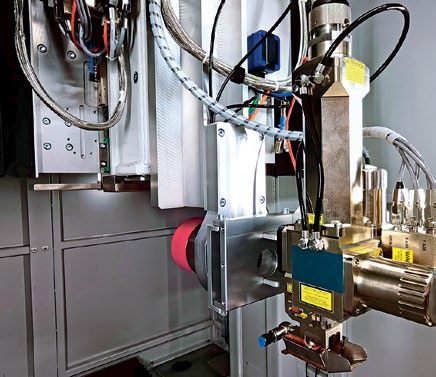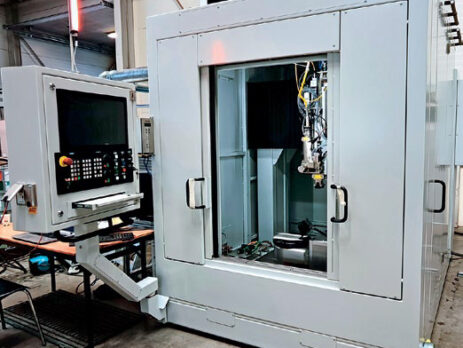Engineering expertise from laser system manufacturers is crucial for demanding applications
Laser systems for demanding three-dimensional welding or machining applications in areas such as industry or research require a high level of engineering expertise from the manufacturer. This applies in particular to the development of individual solutions that meet the specific requirements of the user.
A conversation with a manufacturer and a user shows which aspects of engineering competence are important for the success of an application.
Karl H. Arnold Maschinenfabrik GmbH & Co. KG developed from a special welding shop that already had broad know-how in the area of welding and clamping technology before entering laser technology. Today the company is a manufacturer of complex, fully automated laser systems for demanding manufacturing tasks with three-dimensional beam guidance. The turnkey solutions also include all necessary devices and accompanying processes such as pressing, heating or cleaning stations as well as quality testing, for example using ultrasound technology.
“Our tasks are almost infinitely diverse,” explains Hansjörg Klotz, sales manager at Arnold Maschinenfabrik. That's why there are almost no off-the-shelf systems: almost every system is a custom-made product optimized precisely to the customer's individual tasks. This requires a high level of flexibility and willingness to innovate. When it comes to beam sources, we are not limited to one make, but instead source the most suitable units from leading manufacturers. There are also system solutions in which several different beam sources are integrated. The same also applies to the enormous range of process and automation technologies. There is also a selection of proven supplier partners for this.
“Our tasks now go far beyond the original standard welding of steel and aluminum,” explains Klotz. Today, even exotic materials such as molybdenum-copper composites produced using powder metallurgy are joined, welded joints are produced from die-cast aluminum with rolled aluminum or pressure-tight welded joints on large stainless steel sheets for heat exchangers. Among other things, deep welding, powder deposition welding, soldering and hardening are practiced. A special system even deburrs cut edges by briefly melting them, others solder exotic materials in a vacuum chamber, harden precisely defined surface areas or polish glass components using a laser. There are also extremely sophisticated special solutions for the treatment of grain-oriented electrical sheets for transformer production or for the creation of the finest hole patterns in machine components for paper production.
Another case involved the development of a high-precision beam guide for the continuous welding of cladding sheets to tubes within the narrow gap between tube and sheet during winding. Arnold has its own job shop with easily adaptable systems for tests as well as for order peaks or unusual tasks from customers.

“In view of the variety of customer requests we receive, we design our systems to be as modular and as versatile as possible,” says Klotz.
The resulting possible cost reduction in the basic structure gives developers the freedom to concentrate on optimizing customer-specific special equipment. An example of this type of system is the Flexline 3D laser system, which offers large travel distances in a relatively small footprint. The supporting base frame on which all components are built enables quick transport to the customer after acceptance. The desired 5-axis kinematics can be implemented using various combinations of travel paths, optics and workpiece. The different heads can be quickly exchanged.
“We have been working closely with the Karl H. Arnold company for years on a project that involves the long-term vacuum-tight closure of an electronics housing for satellite use,” says Norbert Müller.
He works at the Ferdinand Braun Institute, Leibniz Institute for High Frequency Technology in DE Berlin. As part of the project, a modular, extremely flexible system of the Flexline type is used, which can be equipped with two different laser sources. A quick coupling interface allows the use of up to three laser optics. The system is compatible with all solid-state laser sources and can be used for research purposes as well as for the development of processes or for processing smaller series. In this case, it is equipped with a 200 W multi-model laser for soldering applications and a 2 kW single-model laser for welding tasks. The primary task is currently the development of a soldering process for an electronics housing, which must safely enclose a sophisticated gas mixture in the vacuum of space for at least 15 years. This soldering process must take place in a specially developed vacuum chamber. Due to space problems at the institute, joint development work has so far been carried out in Arnold's workshops in DE-Ravensburg.
Arnold's experts have always proven themselves to be competent and quick to respond to all questions and problems that arise, says Müller. His employees were able to carry out their tests on the system that was installed ready for operation in Ravensburg. As developers who had to navigate new, complicated territory, you had to ask a lot of questions and often wanted to know exactly. The Arnold employees responded to these special needs of his institute with understanding and helpfulness, and the collaboration always took place in a friendly atmosphere. Such a willingness to take part in a dynamic development that cannot previously be precisely defined by specifications is a great help for him as a researcher. This also became apparent when it turned out that the new hall intended for the facility had a ceiling height that was too low. The designers at Arnold developed a split lid construction specifically for this purpose, which makes it possible to set it up at the new location. The system has now arrived in Berlin and been installed - commissioning is scheduled to take place in the next few days.

